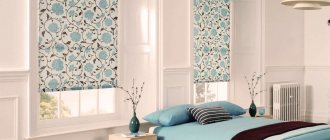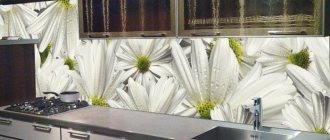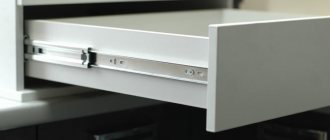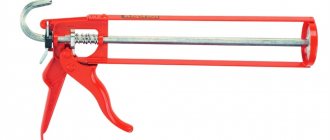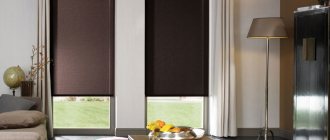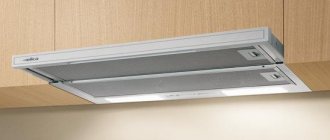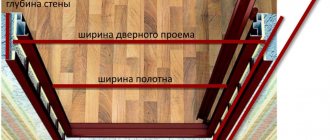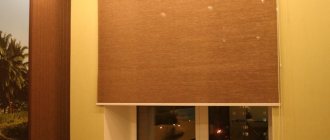Roller shutters for windows (roller shutters) are a type of blinds. They are intended for installation in window openings of buildings and structures for any purpose - industrial, residential, as well as kiosks and shop windows. This is a popular means of protection against burglary and exposure to adverse weather conditions.
The first samples appeared in Ancient Greece. They were made of wood and marble and were used as protection from hot sun rays and as ventilation. Modern systems can withstand high wind loads, provide indoor comfort by providing sound and thermal insulation, and reliably hide buildings from unwanted viewing by unauthorized persons.
What are roller shutters
Fabric roller blinds (roller blinds, blinds) are a window decorative sun protection system. It is a rectangular sheet of fabric wound on a tubular shaft attached at the top of the window. The cloth is impregnated with a special compound, which ensures resistance against fraying of the edges and settling of dust.
Roller shutters are metal products that rise and fall vertically and, when opened, are wound up at the top in the form of a roll.
In addition to traditional rectangular sizes, there are:
- trapezoidal;
- arched:
- triangular.
Non-traditional ones can follow the shapes of windows and roofs. Roller shutters are very popular when equipping window units on the first floors. In winter gardens, the roofs are covered with inclined structures. The control of fabric and metal products is carried out manually or using an electric drive.
Scope of application
Often, private individuals and commercial enterprises become clients of roller shutter manufacturing companies. The popularity is explained by the wide scope of application of roller shutter systems.
Owners of country houses strive to protect their homes from theft and burglary. Apartment owners install decorative elements to protect them from bright daylight. Roller shutters are installed in retail and office premises for security purposes.
An approximate list of roller shutters by method of application:
- window;
- door;
- on glass roofs;
- gate;
- wicket;
- plumbing.
Almost all retail outlets are equipped with roller shutters, which protect huge glass display cases from mechanical impact at night. In boutiques located in large shopping centers, grilles are the most popular.
Rolling gates are made of more durable metal and are installed in garages, parking lots, warehouses and factory workshops. In production premises, large openings are closed with roller shutters equipped with additional gates. Plumbing structures hide utilities and engineering networks in niches.
Advantages
Until recently, metal bars performed protective functions on windows. Such structures were not aesthetically pleasing, required annual painting, and did not meet fire safety requirements. To replace them, designers created roller shutter systems. They reliably protect glass, are easy to use and durable.
The undeniable advantages of roller shutters are:
- reliable protection;
- soundproofing;
- energy saving;
- thermal insulation;
- protection from weather precipitation;
- maintainability;
- safety in operation;
- ease of use.
The presence of such structures on the windows provides residents with comfort and convenience, protecting the home from prying eyes. They fully comply with the standards of fire and security services.
Flaws
Despite a number of advantages, roller shutter designs have minor disadvantages. If you follow the operating rules and gentle care methods, you can avoid many undesirable moments.
Disadvantages include:
- icing due to temperature changes;
- friction and wear of mechanisms;
- corrosion of locks;
- restrictions on the width of the opening;
- reduction of light opening.
Decorative products are less durable due to the soft structure of the material. Basically, all the disadvantages relate to protective fabrics. To extend their service life, it is necessary to carry out a technical inspection of all blinds more often to timely detect and correct deficiencies.
Roller blind
Do-it-yourself fabric roller blinds can be made in another way, without a purchased mechanism. This option assumes the presence of a winding shaft at the bottom of the product, and control will take place using a thick thread, rope or cord. What you need to prepare:
- wooden or aluminum strip;
- construction stapler or double-sided tape;
- pipe with a diameter of 2-5 cm;
- fabric cloth;
- cord;
- stationery clothespins (can be replaced with rings).
The upper part of the material must be attached with tape or a stapler to the bar (cornice), and do the same with the shaft. You can use special high-quality glue. But you shouldn’t overdo it with it: it will dry out and be visible through the fabric. To make the product look neat, the shaft must be completely wrapped in fabric. Therefore, it is better to make the product with a slight overlap in length. On the cornice at both edges, you need to retreat 10-15 cm and secure the fabric with clothespins, lower the ears down. Tie the cord in a knot at the back eye of the clothespin. Then pull it through the bottom of the curtain and thread it through the front ring. Do the same with the second ring.
If the roller blinds are wide enough, then a third cord in the middle will not be amiss. Now all the laces need to be pulled through the front eye of the outer clothespin. The length of the cords should not be less than 70 cm. Then you need to tie it in a knot and cut it. The cornice can be decorated with fabric or other materials.
The roller blind is ready. You can secure it with tape, adhesive tape or small self-tapping screws to the window frame. To raise the blinds, you need to pull the knot of strings tied together. And to fix the curtain in this state, clothespins will come in handy. The curtain is raised to the required height and the position is secured with a clothespin, while grasping the cords and the upper part of the curtain. You can also secure the cords using a hook installed next to the window.
You may also be interested in: Matting curtains in living space design
Classification of roller shutters
Modern manufacturers offer a wide range of products that can satisfy any consumer wish.
According to the classification of roller shutters, they are divided into:
- material of manufacture;
- purpose;
- control method;
- installation option;
- type of construction.
Initially, window shutters were made only of wood and served to regulate the access of air and light.
With the advent of new technologies, other materials began to be used:
- plastic;
- steel;
- aluminum;
- fabric;
- perforated.
There are protective and decorative purposes. Reinforced armored systems are installed in banks and warehouses.
According to the control method they are divided into:
- manual;
- mechanical;
- with electric drive;
- remote.
Installation options depend on the design features of the models and the material of manufacture.
Decorative
Decorative samples serve as window decorations instead of curtains or are combined with curtains. Particularly relevant in rooms located on the south side. Indispensable in educational institutions and kindergartens. In the daytime, putting children to sleep can be very problematic, but once the roller shutters are lowered, the necessary darkness will be created in the sleeping area.
This type is made from:
- plastic;
- fabrics;
- aluminum
Plastic and aluminum lamellas are folded at the top into a cassette box (closed type), fabric (open type) are screwed onto a roller. A variety of colors allows you to choose models that match any design solution. The fabric from which the canvases are formed is divided according to light transmission. These models can be controlled using a cord and a cane handle or with an electric drive.
With open design
Roller blinds with an open design (MINI) are the easiest to manufacture and operate. They are always located indoors. Perform aesthetic and protective functions. During the day, when deployed, they regulate the flow of sunlight, and in the evening they provide a certain atmosphere of privacy and tranquility.
They are a textile fabric wound on a roller; a wooden or plastic strip is sewn underneath as a weighting agent. The lift cord hangs on the side.
The main advantage is its low weight, so it can be attached to:
- sash window;
- wall;
- ceiling.
Now the market has begun to offer models that are hung on the doors with hooks. There is no need to drill extra holes in the profile, you can quickly move it to another room - all these points influenced the increase in sales. For roof windows, the canvases are supplemented with side guides.
Closed
Closed (UNI) cassette-type structures are distinguished by the fact that when open, the shaft and lamellas are completely hidden from view by the box. The curtain or canvas fits tightly to the glass, closing the opening as much as possible. Sliding is carried out along guides to which a weighting agent is attached. Adjustable using a cord, rotary cane or electric drive.
The box body performs a decorative function and is made of:
- plastic;
- wood;
- metal
Mini-blinds (isolight and isotra) with slats 16 mm wide are also equipped with a cassette frame.
Varieties according to the level of light protection
What level of light protection to choose will depend on the type of room and the functional purpose of the curtains. Therefore, the textile industry offers fabrics with different levels of light transmission.
Varieties according to light transmission:
- Transparent - perform a diffusion function. Evenly distributes sunlight throughout the entire room. Usually they act as a decorative element of a window opening.
- Dim-out - combines two missions: transparency and dimming. Very often installed in winter gardens and greenhouses to protect flowers and plants from sunburn.
- Black-out - used when 100% blackout is needed. They are used in cinema halls, bedrooms and diagnostic centers.
- Day-night are fabric or perforated curtains consisting of strips of different light transmittance. One strip is transparent, the second is black-out. By adjusting their position, you can provide or limit the access of light.
Perforated canvases are mainly installed on plastic windows of shops, offices and country houses. In residential apartments they cover unglazed openings of loggias and balconies on the lower floors.
Types by type of control
The type of control for decorative roller shutters will depend on the functional purpose and weight of the product. If a mini roller blind is installed, then there is no need to install an expensive electric drive.
The following types of adjustment are available:
- plastic chain cord or cable;
- spring holder;
- electric motor.
Chain mechanisms are the simplest and inexpensive. By pulling the cord, you can easily roll the fabric. The spring holder is used to secure the weight strip in a certain position between the window glazing beads. With the help of a relaxed spring, the curtain rises up by inertia.
Heavy models are raised and lowered using an asynchronous motor. The motor is turned on and off using a stationary switch or remote control.
Installation with adhesive tape
To avoid making holes in the wall, roller shutters are installed on plastic windows directly on the window frame. This process is considered more labor-intensive. But, despite this, during operation they can come off, which will create an additional problem.
The roller on the adhesive tape may fail due to the fact that sudden temperature changes have a negative effect on the adhesive layer. Listening to consumer reviews, the best way to fix it on a window opening is not tape, but Moment glue.
We assemble the product in the same way as in the previous case. We degrease the curtain fastenings and the places where they are attached to the frame. After the acetone or solvent has dried, glue a neat piece of double-sided tape. If there are protruding edges, they must be cut off immediately so that during operation dust does not accumulate on them and spoil the entire appearance of the window.
You need to glue the roll to the window the first time , so you need to make the markings very carefully. To firmly glue the guide clamps, you need to degrease certain areas. A building level will definitely help you do this. The guide line must be passed through the lower mount and secured.
Protective roller shutters
These roller shutters (roller shutters) consist of a metal profile sheet that is screwed onto a shaft hidden by a protective cassette box. There are guides on the sides; lamellas slide along them; the side covers of the cassette provide rigidity to the entire box and protect the roller from dust.
The thickness of the profile will depend on the required protection class. A wide range of colors allows you to create a large variety of protective systems suitable for any architectural style. Such models are mainly installed outside buildings. Anti-vandal and armored samples are in demand in museums and financial institutions. For country houses, systems with a lower degree of protection are used.
What materials are they made from?
In order for roller shutters to truly perform a protective function, it is necessary to use reliable, strong materials such as steel and aluminum in production. Roller shutters according to the degree of burglary resistance are divided into classes from P1 to P8. The resistance time to illegal actions ranges from 10 to 50 minutes.
Depending on the category, metal lamellas are made from the following profiles:
- Roller rolling, resistance class P1 - intended for private houses, country cottages and shopping pavilions that do not require increased protection against intrusion.
- Extruded double-walled, for degrees of protection up to P4. Installed in pharmacy, bank and museum storage facilities.
- Special thick-walled armored profiles are used in anti-burglary roller shutter systems of the highest classes, in weapons and jewelry stores. In the banking industry, they are installed at cash desks.
To confirm the protection class, products are subjected to static and shock loads. Anti-vandal systems are reinforced with metal thickness and additional stiffening ribs. All metal strips are treated with an anti-corrosion coating and painted with special paints. This two-layer coating ensures the durability of the roller shutters.
Control methods
The method of controlling roller shutters can be done manually or using an electric drive. When installing an electric mechanism, a manual lifting device is additionally installed to protect against unforeseen events.
Approximate list of manual mechanical drives:
- tape;
- corded;
- cord;
- collar;
- spring-inertial.
You can manually operate roller shutters weighing from 15 to 80 kg. Electric drives significantly increase the cost of the entire structure, so they are most often used in high-rise buildings with many windows, where the manual method is physically impossible.
The automated system can be controlled using a remote control. In modern office premises, a method of blocking window openings using a timer is used. This is very convenient and safe: all protective roller shutters close at the same time.
Features of fabric roller shutters
Fabric roller curtains are the fastest and most effective way to decorate a window opening in any room. They can be attached to a wall or ceiling, and with this method they completely close the opening.
There are models that are placed separately on each sash. They save space, are easy to install and maintain - thanks to these qualities they have gained popularity among consumers.
Fabric roller curtains are made from:
- cotton;
- polyester;
- flax;
- bamboo
Thanks to the wide range of colors, they practically match any decorative style. Manufactured in standard and custom sizes. The fabric is treated with special compounds that protect the fabric from fading, moisture absorption and dust settling.
How to choose the right one
To choose the right roller shutters for your windows, you need to decide on their purpose. The principle of raising and lowering also plays an important role.
The selection criteria are influenced by the following factors:
- functionality;
- price;
- product design;
- material of manufacture;
- color scheme;
- control method.
To regulate natural light, fabric curtains and mini-roller shutters made of aluminum are used. Horizontal aluminum roller shutters protect the windows from the effects of precipitation. Maximum protection against burglary is provided by enhanced anti-vandal systems. In them, the box with the mechanism is reliably protected from intruders.
Fabric blinds
Blinds or roller blinds are gaining popularity. They are beautiful and practical. Their only drawback, like many other roller blinds, is their high cost. Not everyone can afford to buy or have such roller blinds made to order, especially for windows in all rooms. But it is possible to make fabric roller blinds for windows with your own hands. This is not a very complicated matter, and the cost is much cheaper. The design of such curtains is simple and clear.
The fabric for making blinds must be dense and intended specifically for such products. Regular and other curtain fabrics are not suitable for use in roller blinds - they complicate the normal functioning of the mechanism.
To make such a design yourself, you need to prepare the necessary material and tools:
- canvas;
- double-sided adhesive tape;
- fabric winding shaft;
- weight for fabric - bar (wood, plastic, aluminum);
- The roller blind mechanism consists of a driving and driven element, a chain with a weight and a lock; the set may include additional brackets for lower fixation.
Methods for installing protective roller shutters
There are three ways to install protective roller shutters: external, internal and combined. To understand which technology to use, it is necessary to study the design of the system before installation.
Roller shutter components include:
- canvas;
- box;
- guides;
- control mechanism;
- locks.
With any installation method, certain requirements must be met, the fulfillment of which will determine the performance and durability of protective roller shutters. The box must be fixed strictly horizontally, the guides must be fixed vertically, at right angles; bends and deviations are not allowed.
Outer
External, which installers sometimes call overhead, is the simplest method of attaching roller shutters, which does not require making a niche for the cassette. The box with slats is installed above the window opening, and the guide rails are attached to the wall.
Characteristic features of this installation:
- used in already constructed buildings;
- suitable for all types of control;
- does not occupy the light opening of the window;
- when closed, it fits tightly to the surface of the walls.
The overhead technique can be used from the street and indoors. If the windows are inserted and the finishing work is completed, then this method will be the only correct solution.
Interior
With the internal method, the guide rails and the box are mounted directly into the window between the slopes. The slats and cassette are attached with hardware to the window profile and to the wall.
The internal method has its own distinctive features:
- reduces the light opening;
- for the drive you have to drill a hole in the frame;
- limits the possibility of installing a mosquito net;
- belongs to a higher class of anti-burglary.
Sometimes this fastening method is used directly during construction.
Combined
The combined installation method is used when reconstructing premises or in new buildings under construction. At the design stage, architects provide special niches above the window openings into which the boxes with the canvas will be fixed.
This is the most reliable method of fastening: to open such a structure, you will have to disassemble the wall. Therefore, it is very important to install protective roller shutters before finishing the façade. Installation of such systems must be carried out by installers with special training.
Preparing the opening
When carrying out preparatory work, it makes no difference whether roller shutters are installed in a window or doorway. The principle and procedure for performing the work will be the same in any case:
- Taking measurements. In order to purchase roller shutters, you first need to measure the opening in which they are planned to be installed.
- Checking the evenness of the opening. Using measuring tools, the diagonals of the opening are measured; they can differ by no more than 5 mm. If this condition is not met, then it will not be possible to achieve the required tightness and safety when installing roller shutters.
The diagonals of the opening can differ by no more than 5 mm
- Checking the horizontal and vertical slopes. To do this, use a building level and plumb lines. Deviations should not be more than 1.5 mm per linear meter.
- Elimination of irregularities, cracks and chips. To do this, use plaster or special overlays to achieve a smooth surface of the opening.
Installation of protective roller shutters
Illiterate installation can deprive the effectiveness of any powerful design. Therefore, before installing protective roller shutters yourself, you need to be 100% confident in your knowledge and skills.
Initially, it is necessary to carry out preparatory measures:
- check the availability of the tool;
- check the completeness of the design;
- measure the light opening;
- if necessary, plaster the slopes.
It is very important to have aids on hand and use high-quality fasteners. Without this, it is not recommended to proceed with installation.
Necessary equipment and tools:
- drill or hammer drill;
- set of drills for concrete and metal;
- pliers and wire cutters;
- screwdriver with a set of bits;
- set of screwdrivers and keys;
- level;
- hammer;
- marker;
- roulette;
- sealant;
- riveting gun;
- scissors for cutting metal;
- stepladder or ladder.
During the work process, the sequence of operations must be strictly observed. To connect the electric drive, you will additionally need an indicator screwdriver and a multimeter.
Installation procedure:
- Using a marker on the side guides, mark places for drilling at equal intervals of 40-50 cm. Make holes with a diameter of 8 mm. For the overhead method, drill out the top rail to 12 mm to secure the decorative plugs.
- Next, you should attach the cover to the cassette and drill through two holes on both sides with a diameter of 4 mm for installing rivets after finishing the work. The location of the holes for the box will depend on the installation method: at the back - for external, at the top - for internal and in both planes - for combined. Use a drill with a diameter of 8 mm. Drill a passage for the drive. Assemble the box and guide rails.
- Try the assembled frame onto the window opening. Use a level to check the horizontal, vertical and diagonal dimensions of the structure. The permissible error should not exceed 2 mm. Use a marker to make markings on the wall or frame through the holes in the profile.
- Remove the attached roller shutter and punch holes using a puncher or drill according to the markings. Insert dowels into the concrete wall. Push the protective spring into the drive passage.
- Remove the protective films from the frame and install it in place, and check the parameters again with a level. Align the markings and secure the block with self-tapping screws using a screwdriver.
- Install control elements indoors. Use a marker to mark the drilling locations, drill and secure the mechanism to the internal slope or wall. Attach the guides and tape guide.
- Install the canvas. To do this, distribute the spacer rings on the shaft in increments of 40 cm. Install a support element on both sides on the end rail of the web. Insert the canvas from above into the guide rails. Place the traction springs along the upper edge and secure them in the shaft holes.
- Secure the box lid with rivets. Remove dirt and install limiters. Close all holes with plugs treated with sealant.
After carrying out all the work, it is very important to check the protective system for opening and closing. The slats should slide smoothly and without squeaking.
The connection of the electrical control system must be carried out by an electrical installation specialist. Roller shutters are heavy, so to perform the installation efficiently, you need help.
DIY installation of decorative roller shutters
It is very easy to install decorative roller shutters with your own hands; to do this, you need to carefully study the attached instructions.
Sequence of work:
- Check product completeness and dimensions. To do this, remove the packaging and try the curtain on the window unit.
- Insert the brackets and connect the blade to the shaft.
- Place it on the window and make a mark with a marker.
- Initially, you need to fix the bracket on which there is no control.
- Fix the second one (with the chain), check the horizontal position with a level.
- Insert limiting elements and clamps.
- Adjust the chain and check the functionality of the structure.
Fabric blinds are lightweight, so you can decorate the window without help.
Sizing
If a decorative curtain was purchased ready-made in a store, but at home a discrepancy in size was discovered, then you can adjust the parameters at home.
Sizing is done as follows:
- Measure the height and width of the light opening. This will be the distance between the horizontal and vertical beads.
- Unfold the blade, remove it and trim the shaft to the desired length.
- Trim the bottom weight strip. Its size should be 10 mm larger than that of the shaft.
- Cut the fabric slightly less wide than the shaft.
- Insert the roller and weighting material into the panel.
To perform these works you will need a hacksaw and a long ruler.
Fastening the roller shutter with self-tapping screws
Attaching roller blinds to self-tapping screws is the easiest and fastest method. They are usually included with the product.
The work must be performed in the following sequence:
- Try the assembled fabric curtain on the window unit and check the dimensions.
- Using a level, level and mark the mounting points.
- Drill the required holes using a screwdriver.
- Assemble the curtain.
- Screw the first bracket using self-tapping screws.
- Insert the canvas.
- Attach the second bracket and pass the chain through the special hole.
- Check the operation of the roller blind.
Installation work is simple; very often women install such structures themselves.
Recommended set of tools and accessories required for installing roller shutters.
Expand
| Tool name | Quantity |
| Electric hammer drill | 2 |
| Electric drill | 1 |
| Cordless screwdriver | 1 |
| Electric corner cutting machine | 1 |
| SDS adapter with keyless chuck | 2 |
| Rivet gun | 2 |
| Construction block level 1.5m | 1 |
| Tool box | 2 |
| Bench hammer 400 gr | 2 |
| Sledgehammer | 1 |
| Set of percussion instruments (chisel, bolt, punch, punch) | 1 |
| Hacksaw for metal | 1 |
| Metal scissors | 1 |
| Pliers | 1 |
| Medium side cutters | 1 |
| Set of files | 1 |
| Carbide screwdriver set | 1 |
| Set of wrenches | 1 |
| Universal ladder 4 folds | 1 |
| Universal ladder, 3 sections (more than 6m) | 1 |
| Silicone gun | 1 |
| Tester device | 1 |
| Electric soldering iron 60 W | 1 |
| Electrical extension cord no less than 30 m | 1 |
| Screwdriver el. indicator | 1 |
| Tape measure 5 m | 1 |
| Vernier caliper 125 mm | 1 |
| Safety glasses | 2 |
| Construction helmet | 3 |
| Universal first aid kit | 1 |
| Standard set of metal drills | 1 |
| Concrete drill O 6 mm L=160-200 mm | 2 |
| Concrete drill O 8 mm L=200-260 mm | 2 |
| Concrete drill O 10 mm L=550 mm | 2 |
| Concrete drill O 12 mm L=550 mm | 2 |
| Concrete drill O 14 mm L=750 mm | 2 |
| Concrete drill O 16 mm L=950 mm | 1 |
| Concrete drill O 18 mm L=550 mm | 1 |
| Concrete drill O 20 mm L=550 mm | 1 |
| Note: The recommended size of the installation team is 3 people: electrician - 1 person, fitter - 2 people. | |
Before you begin installing the roller shutter, you need to check that all the equipment is included.
Care instructions
Caring for protective and decorative roller shutters is not at all difficult. If necessary, metal products can be cleaned of dirt with a soap solution. Aluminum blinds can be wiped with a damp cloth. Fabric ones are removed from dust using a vacuum cleaner.
When using external systems for a long time, sometimes it becomes necessary to tint the slats; in such cases, cans of metal paint help to cope with the task. In winter, the locks must be lubricated with machine oil.
